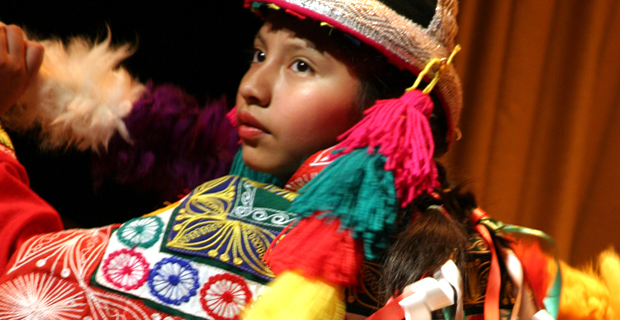Dance
Pachamama Peruvian Arts offers weekly instruction free of charge to children ages seven to fourteen in dance forms such as the marinera limeña and norteña, festejo, and huayno, as well as musical instruction on the cajón (box drum), antara (Andean panpipe), and charango (Andean guitar). Our class schedule changes every semester to offer our students a chance to explore the vast cultural forms of Peru. Some 1500 musical genres are performed throughout the country!
Festejo
Now one of the most popular and representative Afro-Peruvian dances, today’s festejo probably began in Lima during the 19th century. It is performed by couples who both insinuate and avoid physical contact. Festejo is danced at social occasions especially among the Afro-Peruvian communities of Peru’s coast.
Huayno
Huayno is one of the most representative dances of the Andes. Dating from pre-Colombian times, huayno blended early with Western influences and spread into dozens of regional variations. Huayno is danced in couples, though little physical contact is made. The dance culminates with an energetic tap dance to mark time.
Marinera Norteña
Inspired by the Spanish dance zamacueca, marinera developed during Peru’s colonial period (1532-1821) and was later given the name marinera in honor of the Peruvian Marines victory over Chile in the war of 1879. The dance is performed by couples using handkerchiefs as props. It is quick paced and considered the national dance of Peru.
Marinera Limeña
This marinera is an elegant dance performed by couples. Handkerchiefs are also used. It is generally more slow paced than marinera norteña. The dance consists of three parts: the marinera, the resbalosa and the fuga.
Carnaval de Canas
Carnaval de Canas is a cuzqueña dance from the province of Espinar, in the southern section of Cuzco. Also known as pucllay, Carnaval de Canas is characterized as very festive and picaresque. It is danced at carnivals during the months of February and March. Carnaval de Canas is danced in pairs (usually young couples) who use the dance, song, and a charango to flirt with, and ultimately conquer, their partner.
Tondero
The tondero is a very expressive dance with joyful rhythms from the coast of the department of Piura; (although each province has its distinct style). This dance has three parts, each clearly defined and demonstrative of its roots in indigenous, African, and Spanish culture. In the first part, the “lament” comes from the harawi (a poetic indigenous song). In the second part, the rhythm is derived from the zamacueca (a mix of Spanish and Afro) and then lastly is the ground strike, an exclusively Afro contribution.
Alcatraz
The Alcatraz is an Afro-Peruvian dance from Peru’s coast belonging to the festejo genre. This festive and erotic couples’ dance is usually performed in the departments of Lima and Ica. Alcatraz historically had its own proper choreography where the man and woman danced rhythmically, with papers attached to their waists. The man, holding a lit candle, tried to light the cone of paper while the woman danced, moving her hips. In the choreography practiced today, the woman also tries to light the man’s paper on fire.
Negrillos
Negrillos is a dance that originates from the department of Arequipa. It represents blacks, during and after the abolition of slavery. The men would carry baskets on their heads with farm products to sell and approach women to flirt with them. The women, on most occasions, would cordially and and flirtatiously decline.
Carnaval de Ichu
Carnaval de Ichu is a traditional dance from the Peruvian highlands, commonly performed during the harvest season to give thanks to mother Earth for her bounty. Men and women form two lines so that when facing each other, they are in pairs. Instruments called pinkillos (flutes found throughout the Andes) are also used.
Tuntuna
Black slaves were taken to work at the mines in the Peruvian highlands. Their music and rhythms mixed with the those in the Andes and tuntuna was born. The music is upbeat and has a fast tempo. The dance is performed during the Virgen de Candelaria festival and carnivals in Puno.
Valicha
Valicha is one of the most emblematic dances from the department of Cusco. It is a huayno composed by Miguel Angel Hurtado, who fell in love with a beautiful Incan woman named Valicha Huillca.
Carnaval de Arapa
Carnaval de Arapa is a dance from Puno, in thanks to mother Earth for her bounty. The dance is a ritual that lasts a entire week, beginning on January 20, and is part of Carnaval Chico or small carnival. Men and women wave white flags which represent love.
Inga
Inga is an Afro-Peruvian dance, part of the festejo genre. A group of dancers surround one carrying a baby doll in his/her arms. There is no set choreography so improvisation plays a large role. Movements are fluid and sensual.
Pasacalle Ayacuchano
Dance from the department of Ayacucho in south-central Peru.
Caporales
Dance from Puno
Chachaschay
Dance from Huancavelica in in south-central Peru.
This post is also available in: Spanish

 English
English  Spanish
Spanish 
